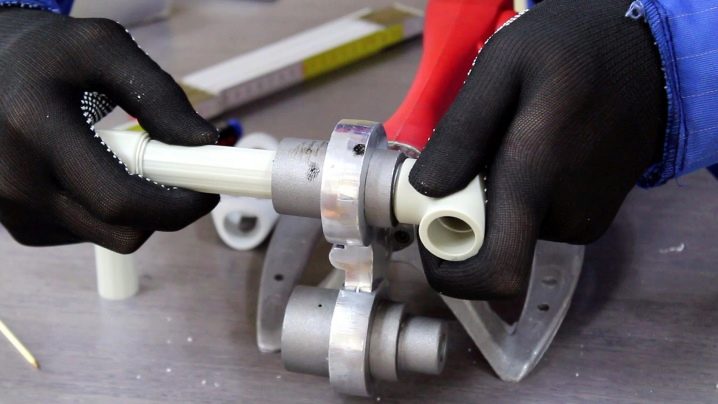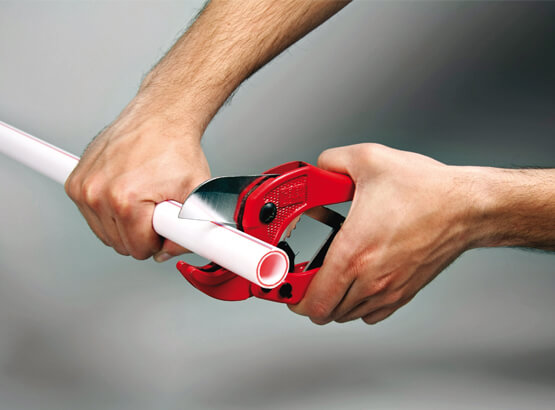POLİPROPİLEN BORU SİSTEMLƏRİNİN MONTAJ QAYDALARI
Qaynaq əməliyyatı necə həyata keçirilməlidir?
Qaynaq əməliyyatı detalların axıcılıq həddinə kimi qızdırılıb müəyyən təzyiq altında bir-birinə sıxılmış vəziyyətdə soyudulması yolu ilə həyata keçirilir. Polipropilenin qaynaq olma xüsusiyyəti eyni materialdan hazırlanan boruların quraşdırılmasını asanlaşdırır və digər üsullarla müqayisədə qaynaq birləşmələrində yüksək keyfiyyəti təmin edir. Nəticədə iki polipropilen boru bölünməz bir birləşmə əmələ qətirir. PPRC borular bir-birinə keçid və yaxud birləşdirici mufta, dirsək və s. vasitələrlə birləşdirilir. Boru və fitinqlər qaynaq zamanı insan orqanizminə təsir edə biləcək zərərli maddələr ifraz etmir.
Qaynaq əməliyyatını istismar qaydalarına uyğun, saz alətlərlə aparmaq lazımdır.
Qaynaq 220V cərəyan altında, ГОСТ 12.2.007-75* uyğun təhlükəsizlik tələblərinə müvafiq aparılmalıdır. Qaynaq aparatından istifadə zamanı dielektrik ayaqaltı və əlcəkdən istifadə edilməlidir.
Boruların qaynağı qızdırılmış halda və təzyiq altında aparılır.
Qaynaq üçün aşağıdakı alətlər tələb olunur:
- Qaynaq aparatı (1500 Vt) *
- Qızdırıcılar (⌀20, ⌀25, ⌀32, ⌀40)
- Boru kəsici qayçı
- Metrə
- Səviyyə ölçən
- İstismar təlimatı

* Diametri 40 mm-dən yuxarı olan borular üçün bu gücə hesablanmış xüsusi qaynaq aparatından istifadə olunur.
Qaynaq prossesi




1. İşə başlamazdan öncə boruların və birləşdirici hissələrin təmiz olmasından əmin olun. Təmiz olmadıqda onları spirtdə isladılmış əski ilə təmizləyin.
2. Qaynaq aparatını işə salın və hər iki indikator lampasının yanmasından əmin olun. Lazımi hərarətə nail olduqda və aparatın ikinci indikator lampası avtomatik söndükdə işə başlamaq olar.
3. Boruların qaynağı üçün birləşdiriləcək hissələri boru və fitinq aparatının qızmış hissələrinə keçirin. İsinmə vaxtını gözləyib borunu döndərmədən hissələri müvafiq fitinqlər ilə birləşdirin.
4. Qaynaqdan sonra soyuma vaxtını gözləyin. Qızma və soyuma vaxtını təyin etmək üçün bu cədvəldən istifadə edin:
260°C-270°C temperaturda qaynaq edilən PPRC boru və fitinqlərin diametrinə görə texnoloji qaynaq müddətləri.
| Borunun çöl diametri, mm | Qızdırılma müddəti, san. | Qaynaq müddəti, san. | Soyuma müddəti, san. |
|---|---|---|---|
| 20 | 5 | 4 | 120 |
| 25 | 6 | 4 | 180 |
| 32 | 8 | 4 | 240 |
| 40 | 12 | 5 | 240 |
| 50 | 18 | 5 | 300 |
| 63 | 24 | 6 | 360 |
| 75 | 30 | 6 | 390 |
| 90 | 40 | 6 | 390 |
| 110 | 50 | 10 | 480 |
5. Boru kəmərinin quraşdırılmasından sonra onu təzyiq altında sınamaq lazımdır. Boru kəmərlərinin sınağı СНиП 3.05-85 standartlarına uyğun keçirilir. Boru kəməri onu su ilə doldurduqdan ən az 14 saat sonra sınaqdan keçirilir. Sınaq müsbət temperatur şəraitində keçirilir.
Sınaq keçirmə qaydaları
Hidravlik sınaqlar ustanın və ya istehsalçının iştirakı ilə aparılmalıdır.
Təzyiq: 1.5 MPa
Sınaq müddəti: tıxaclar sistemdən çıxarıldıqdan və boruda təzyiq ən yüksək həddə çatdıqdan 1 saat sonra.
Təzyiqin maksimum düşmə həddi: 0.02 MPa (0.2 bar)
Sınaq zamanı monometrin göstəricisi aşağı düşərsə bu, şəbəkədə sızmanın olması deməkdir. Belə hallarda borular əvəz olunur, yaxud yenidən birləşdirilir.